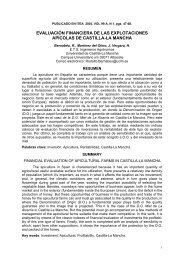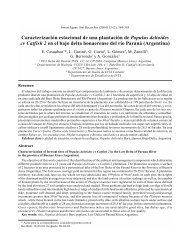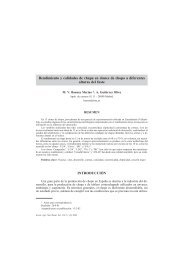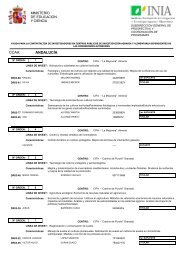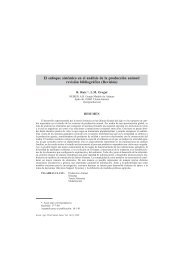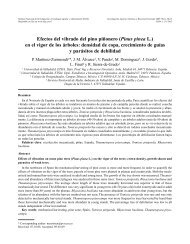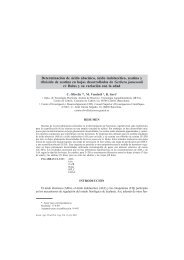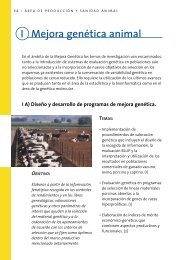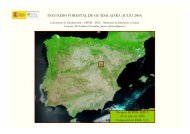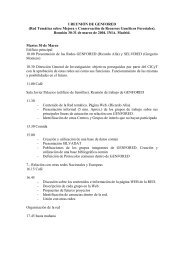Status of medicinal and aromatic plants in - Inia
Status of medicinal and aromatic plants in - Inia
Status of medicinal and aromatic plants in - Inia
You also want an ePaper? Increase the reach of your titles
YUMPU automatically turns print PDFs into web optimized ePapers that Google loves.
PRESENTED PAPERS 139<br />
Regard<strong>in</strong>g <strong>medic<strong>in</strong>al</strong> plant process<strong>in</strong>g, it is known that the world's annual production <strong>of</strong><br />
essential oils is at least 45 000 tonnes (Verlet 1993). However, Serbian producers do not<br />
operate on the world market because <strong>of</strong> variable yields <strong>and</strong> quality <strong>and</strong> lack <strong>of</strong> technical<br />
<strong>in</strong>formation to overcome these problems (Menković et al. 1997). The largest quantities <strong>of</strong><br />
essential oils are obta<strong>in</strong>ed from species both <strong>in</strong>digenous <strong>and</strong> cultivated <strong>in</strong> Serbia, such as<br />
m<strong>in</strong>t, juniper tree, lemon balm, thyme, chamomile, dill, parsley <strong>and</strong> valerian.<br />
Only recently, mostly <strong>in</strong> the private sector, more attention has been paid to essential oil<br />
distillation from <strong>plants</strong> such as Levisticum <strong>of</strong>fic<strong>in</strong>ale, Angelica archangelica, Ocimum basilicum<br />
<strong>and</strong> Ech<strong>in</strong>acea angustifolia (Dajić <strong>and</strong> Stevanović 2001). Unfortunately, it is very difficult to<br />
estimate the amount <strong>of</strong> essential oils produced annually <strong>in</strong> Serbia, but it is believed to range<br />
between a few hundred kg <strong>and</strong> up to 10 000 kg.<br />
In developed countries, agriculture produces a surplus <strong>of</strong> traditional crops <strong>and</strong> this is to<br />
be restricted. Council regulation EEC 1765/92 <strong>and</strong> its updates established a support system<br />
for producers <strong>of</strong> certa<strong>in</strong> arable crops. Although cereal areas should be reduced, it is<br />
permitted to use set-aside l<strong>and</strong> for "non-food" crops; <strong>medic<strong>in</strong>al</strong> <strong>plants</strong> <strong>and</strong> spices belong to<br />
this category, which is not restricted, but supported (Németh 2000).<br />
Current research on MAPs <strong>and</strong> further prospects <strong>and</strong> goals<br />
In addition to <strong>in</strong>vestigations on MAP biology, diversity <strong>and</strong> population mapp<strong>in</strong>g, significant<br />
research is conducted on breed<strong>in</strong>g, selection <strong>and</strong> <strong>in</strong>troduction <strong>of</strong> wild MAPs (Institute for<br />
Medic<strong>in</strong>al Plant Research, Belgrade; Department for Medic<strong>in</strong>al Plants, Bački Petrovac;<br />
Faculty <strong>of</strong> Agriculture, University <strong>of</strong> Belgrade <strong>and</strong> Novi Sad).<br />
The ma<strong>in</strong> achievements <strong>in</strong> MAP breed<strong>in</strong>g <strong>and</strong> selection <strong>in</strong> F.R.Y. are reflected <strong>in</strong> the<br />
number <strong>of</strong> domestic cultivars (Table 3).<br />
Table 3. Domestic or improved MAP cultivars <strong>in</strong> F.R. Yugoslavia (source: Kišgeci et al. 1997;<br />
Adamović 2000)<br />
Species<br />
No. <strong>of</strong><br />
cultivars<br />
Species<br />
No. <strong>of</strong><br />
cultivars<br />
1 Achillea millefolium L. 1 26 Majorana hortensis Moench. 4<br />
2 Acorus calamus L. 1 27 Malva silvestris L. 3<br />
3 Agrimonia eupatoria L. 1 28 Melissa <strong>of</strong>fic<strong>in</strong>alis L. 3<br />
4 Althaea <strong>of</strong>fic<strong>in</strong>alis L. 1 29 Mentha x piperita L. 5<br />
5 Anethum graveolens L. 2 30 Mentha spicata L. 1<br />
6 Angelica archangelica L. 2 31 Ocimum basilicum L. 4<br />
7 Artemisia abs<strong>in</strong>thium L. 1 32 Oenothera biennis L. 1<br />
8 Artemisia dracunculus L. 2 33 Origanum vulgare L. 1<br />
9 Borago <strong>of</strong>fic<strong>in</strong>alis L. 2 34 Papaver somniferum L. 1<br />
10 Calendula <strong>of</strong>fic<strong>in</strong>alis L. 1 35 Pimp<strong>in</strong>ella anisum L. 1<br />
11 Carum carvi L. 4 36 Ric<strong>in</strong>us communis L. 1<br />
12 Chamomila recutita (L.) Rausch. 3 37 Ruta graveolens L. 2<br />
13 Chrysanthemum c<strong>in</strong>erariaefolium L. 1 38 Salvia <strong>of</strong>fic<strong>in</strong>alis L. 1<br />
14 Cochlearia armoracia L. 1 39 Salvia sclarea L. 2<br />
15 Cori<strong>and</strong>rum sativum L. 5 40 Satureja hortensis L. 2<br />
16 Cynara scolimus L. 1 41 Satureja montana L. 1<br />
17 Datura <strong>in</strong>noxia Mill. 1 42 Sideritis scardica L. 1<br />
18 Digitalis lanata Ehrh. 1 43 Silybum marianum (L.) Gaertn. 1<br />
19 Foeniculum vulgare Mill. 5 44 S<strong>in</strong>apis alba L. 1<br />
20 Glycyrrhiza glabra L. 1 45 Thymus vulgaris L. 4<br />
21 Gypsophila paniculata L. 1 46 Trigonella foenum-graecum L. 1<br />
22 Hyssopus <strong>of</strong>fic<strong>in</strong>alis L. 2 47 Urtica dioica L. 1<br />
23 Lav<strong>and</strong>ula angustifolia Mill. 1 48 Valeriana <strong>of</strong>fic<strong>in</strong>alis L. 3<br />
24 Leonurus cardiaca L. 1 49 Verbascum densiflorum Bert. 1<br />
25 Levisticum <strong>of</strong>fic<strong>in</strong>ale Koch. 1<br />
Total no. <strong>of</strong> cultivars = 89




